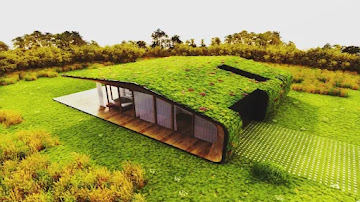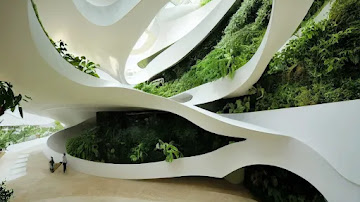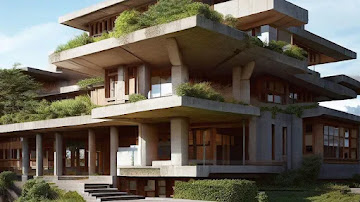The 14 patterns of biophilic design have gained importance in recent years, especially in the field of architecture and interior design. But what exactly is biophilic design and why should we be interested in it? In this article, we will explore the concept of biophilic design, its advantages and disadvantages, and how it is applied in environments such as hospitals.
Biophilic design in offices and hospitals primarily is a
term used in the construction industry to describe how to employ direct,
indirect, and space and place variables to promote human connection with the
natural world.
It is suggested that this concept, when used at both the
building and city scale, has few negative effects on the health, environment,
and economy of building occupants and the urban environment. The Hanging
Gardens of Babylon is an example of biophilic design, although the term was not
created until recently.
Learn more about: Architecture and Design News
What is biophilic design?
Biophilic design is a trend in architecture and interior
design that seeks to integrate elements of nature into built spaces. The idea
behind it is that by surrounding ourselves with natural elements, we can improve
our health, well-being, and quality of life. Examples include incorporating
plants and vertical gardens, using natural materials, and creating spaces that
allow natural light to enter.
The goal of biophilic design is to satisfy our innate need
to identify with nature in the context of contemporary built environments.
Biophilic design, which is an extension of the philosophy of biophilia,
recognizes that our species has evolved for over 99% of its history as an
adaptive reaction to the natural environment rather than to man-made or
artificial factors.
Our bodies
evolved to associate with natural elements and processes. This desire is still
considered to be crucial to the physical and mental health, fitness, and
well-being of individuals, rather than a vestige or relevant to a world that no
longer exists.
Given that
today we spend 90% of our time in the built world that is often considered our
"natural habitat," biophilic design incorporated into interior space
aims to satisfy our fundamental need to feel connected to nature in
contemporary structures and cities. Therefore, the primary goal of it is to
provide suitable habitats for humans as biological beings residing in
contemporary buildings, landscapes, and communities.
In
principle, biophilic interior design focuses on those elements of nature that,
throughout evolution, have benefited our health and well-being, since, at its
core, biophilic is about evolved human impulses. Let's face it: no
manifestation of nature in the built environment can be considered biophilic
design if it has nothing to do with the innate traits of our species that have
enhanced our fitness and survival.
Advantages of biophilic design
According
to the authors, the biophilic design offers numerous advantages, both for the
people who inhabit the spaces and for the environment, such as:
- Improved health and well-being: Studies have shown that the presence of natural elements in interior spaces can reduce stress, improve concentration and increase overall satisfaction with the environment.
- Energy savings: By taking advantage of natural light and encouraging natural ventilation, biophilic design can help reduce energy consumption and, consequently, reduce greenhouse gas emissions.
- Aesthetically appealing: Natural elements often bring a sense of calm and beauty to spaces, which can make working and living environments more pleasant and attractive.
Disadvantages of biophilic design.
Despite its
many benefits, the biophilic design also has some disadvantages:
- Cost: Incorporating natural elements and environmental management systems into a building can increase construction and maintenance costs.
- Maintenance: Plants and other natural elements require regular maintenance, which can generate additional labor and expense.
- Space: In some cases, incorporating natural elements into the design of a building can reduce the usable space available.
Biophilic design in hospitals
Any
individual can benefit from exposure to biophilic design due to their natural
affinity. However, biophilic in hospital care has many favorable effects on
patients, especially those in facilities that have adopted biophilic design
principles.
The design
and idea of biophilic architecture have been found to provide these patients
with significant therapeutic benefits. In this way, the patient's ability to
recover can benefit from direct natural inclusions and interpretations.
One of the
many advantages of biophilic design in hospitals is its impact on stress. This
discomfort often plays an important role in slowing down the body's ability to
heal and recover.
That said,
studies have shown that when patient rooms have views of nature, fewer
painkillers are administered and the patient's overall condition is better.
According
to statistics, the use of biophilic architecture principles in hospitals has
reduced the need for analgesics by 22% and post-operative recovery time by
8.5%.
Biophilic
design is especially relevant in environments such as hospitals, where the
well-being of patients and staff is paramount. Some ways in which biophilic
design has been applied in hospitals include:
- Therapeutic gardens: These outdoor spaces are specifically designed to promote relaxation and recovery for patients. They can include elements such as walking paths, fountains, and rest areas.
- Natural light: Natural light is essential to regulate our circadian rhythms and keep us alert and active throughout the day. In hospitals, natural light can be incorporated through windows, skylights, and lighting systems that mimic daylight.
- Natural materials: The use of natural materials such as wood and stone in construction and interior design can bring a sense of calm and connection to nature.
Unfortunately,
contemporary society has not done enough to support people's need to connect
with nature, erecting various barriers that prevent a satisfying encounter with
it and often considering nature as a mere source of raw materials to transform
through technology or as a pleasant but non-essential recreational and
aesthetic amenity. Modern agriculture, industry, education, health care, urban
planning, and architectural design show an increasing detachment from nature.
The
prevailing practice of placing people in artificial, sensory-deprived
environments such as office buildings, hospitals, schools, and shopping malls
with almost no contact with natural forces and sensations highlights the modern
idea that humans no longer need to relate to nature. Natural light, air,
vegetation, views, environmental forms, and other developed affinities with the
natural world are present in much of today's built environment.
These
constructions resemble the sensory-depleted, bare sensory cages of the old
zoos, which ironically are now banned as "inhumane." These
ecologically deficient environments encourage fatigue, symptoms of illness, and
poor performance, something we are only now beginning to understand. By
simply adding natural sunlight, outdoor views, and vegetation, we can improve
health and productivity.
The main task of biophilic design is to address these
shortcomings of the contemporary built environment by establishing a new
framework for the positive presence of nature. Following the fundamental
principles mentioned above is the first step in using this design scheme
effectively.










